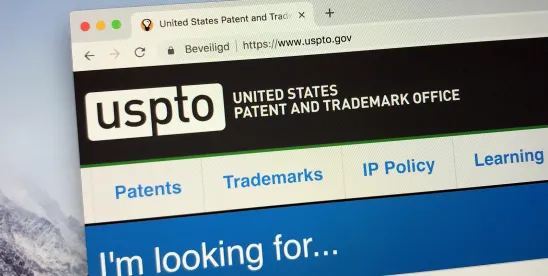The United States Patent and Trademark Office (USPTO) has issued a Memorandum to the Corps of Patent Examiners1 (the “Guidance”), attempting to provide clarity in the wake of the Federal Circuit’s highly anticipated en banc opinion in LKQ v. GM (the “Opinion”).2 The question at issue for the Federal Circuit was “whether Supreme Court precedent . . . should cause us to rethink the long-standing Rosen-Durling test used to assess nonobviousness of design patents.”3 In the Opinion, the Court overruled the 40 year-old Rosen-Durling test and outlined a new framework used to determine nonobviousness based on a longstanding framework used in utility patents as laid out in Graham4.
Stakeholder Concerns
Unless there is further guidance from the Supreme Court, it will remain in the hands of the USPTO, practitioners, and trial courts to determine the nonobviousness of claimed designs and the validity of issued designs as nonobvious by attempting to conform to the Graham framework. The design world is now in the scenario warned of in GM’s brief, and several amici, that overruling the Rosen-Durling test could lead to confusion, disrupt settled expectations, leave courts and the USPTO without clear guidelines for conducting obviousness analyses, and expose many issued U.S. design patents to substantial uncertainty.5 As a practical matter, there may be limits on the ability of design patent applicants and design patent holders to obtain certainty in their properties until further caselaw develops and the examining corps recalibrates to the new Guidance.
Presumably, the USPTO issued the Guidance shortly after the Opinion in order to avoid unnecessarily long delays in examination while caselaw surrounding nonobviousness of designs begins to settle.
Discussion of LKQ Decision
Background
GM Global Technology LLC (GM) alleged that LKQ Corporation (LKQ), a former licensee, infringed U.S. Design Patent No. D797,625 directed to a front fender.6 In response, LKQ alleged that the ’625 Patent was obvious in view U.S. Design Patent No. D773,340 to Lian (Lian) and another vehicle fender.7 The Patent Trial and Appeal Board (PTAB) applied the Rosen-Durling test and concluded that Lian did not qualify as a primary reference (Rosen reference).8
A three-judge panel of the Federal Circuit upheld the PTAB’s decision, finding that Lian and the ’625 Patent created different overall impressions.9 In addition, the panel declined to address LKQ’s argument that the Supreme Court’s KSR10 decision implicitly overruled the Rosen-Durling test, citing a lack of clear directive from the Supreme Court to undertake such an analysis.11 The Federal Circuit granted a rehearing en banc, seeking further briefing on whether KSR affects the Rosen-Durling test.12
The Old Test, Rosen-Durling
Rosen-Durling was a two-part test long used to assess the nonobviousness of a claimed design. The two steps were as follows:
- “[b]efore one can begin to combine prior art designs . . . one must find a single reference, ‘a something in existence, the design characteristics of which are basically the same as the claimed design.’”13 If no Rosen reference is found, the obviousness inquiry ends without consideration of step two.14
- "Once this primary reference is found, other references may be used to modify it to create a design that has the same overall visual appearance as the claimed design.”15 Any secondary references must be “so related” [to the primary reference] that the appearance of certain ornamental features in one would suggest the application of those features to the other.16
The Decision
The Court held that the Rosen-Durling framework is “improperly rigid” and that “[t]he statutory rubric along with Supreme Court precedent including Whitman Saddle, Graham, and KSR, all suggest a more flexible approach than the Rosen-Durling test when determining obviousness.”17 The Court drew upon the reasoning and principles given in both KSR and Whitman Saddle to address the combination of prior art references in both the utility and the design context.
With respect to the first step, Rosen, the Court noted that in KSR the Supreme Court held that transforming a “general principal into a rigid rule that limits the obviousness inquiry” is error.18 Using this reasoning, the Court concluded the Rosen reference requirement to be a rigid rule inconsistent and irreconcilable with KSR.19 For the second step, Durling, the Court also relied on KSR and similar reasoning to find that the “so related” requirement of Durling is overly rigid and inconsistent with the flexible approach favored by the Supreme Court in KSR.20
The New Framework for Determining Obviousness
With the overturning of the Rosen-Durling two-prong test, the Court reached back to Graham to provide a new framework for evaluating obviousness of a design under section 103 by considering the following inquiries:
- the scope and content of the prior art;
- differences between the prior art and the claims at issue;
- the level of ordinary skill in the pertinent art; and
- secondary considerations such as commercial success, long felt but unsolved needs, or failure of others.21
While the framework was outlined, the Court declined to apply the factors to the pending case. Instead, the Court remanded the case to the PTAB to apply the framework to the case at hand.22 In response, the Guidance points design examiners to Chapter 2141 of the Manual of Patent Examining Procedure (“MPEP”) for guidance in conforming to the Opinion23. Chapter 2141 attempts to detail a proper application of Graham and its progeny, though patent examiners have typically referred to that section of the MPEP for guidance in determining nonobviousness of utility patent applications, while the Rosen-Durling test was relied upon for nonobviousness determinations of design patent applications.
It is notable that the Court attempted to detail the scope and content of the prior art as a limit on what would be known to a person of ordinary skill and to guard against impermissible hindsight.24 Specifically, the Court acknowledged that art from the same field of endeavor as the claimed invention would be analogous art, but then noted that references “reasonably pertinent” to the problem addressed by the inventor are less clear in design matters. The Court stated that “[w]hether a prior art design is analogous to the claimed design . . . is a fact question to be addressed on a case-by-case basis.”25 This leaves open the question of where the limits of analogous art lie.
Discussion of the Guidance
The Guidance issued by the USPTO echoes the Federal Circuit in trying to place some boundaries on what may qualify as analogous art for design patent examiners. For example, where a piece of prior art is outside the field of endeavor of the claimed design, the Guidance emphasizes the need for a motivation to combine the prior art in determining whether it qualifies as analogous art, stating: “design examiner[s] should consider the degree to which an ordinarily skilled designer would be motivated to consider other fields.”26 Such a framework would appear to follow Supreme Court and Federal Circuit guidance in remaining flexible while attempting to prevent exotic prior art combinations. Recognizing that such inquiries may be new territory for many design patent examiners, the Guidance suggests that examiners consult with their supervisor in the short term, while a bank of reliable examples is compiled by the USPTO in the long term.27
Moving Forward
For new design patent applicants, it may be important to tailor applications to limit the scope and content of the prior art by controlling what can be considered analogous prior art to the claimed design. Secondary indicia of nonobviousness may find a new place of importance in combating obviousness rejections and validity challenges. There will undoubtedly be further developments in the coming months, with the Guidance promising further guidance and training.28 As such, anyone seeking design coverage should consult with a skilled design attorney or agent before filing to make sure any application is in the best condition possible to navigate these newly uncertain waters.
1Updated Guidance and Examination Instructions for Making a Determination of Obviousness in Designs in Light of LKQ Corp. v. GM Global Technology Operations LLC, May 22, 2024 (last accessed May 24, 2024).
2LKQ Corp. v. GM Glob. Tech. Operations LLC, No. 2021-2348, 2024 U.S. App. LEXIS 12139 (Fed. Cir. May 21, 2024).
3LKQ Corp. v. GM Glob. Tech. Operations LLC, No. 2021-2348, 2024 U.S. App. LEXIS 12139 at *5 (Fed. Cir. May 21, 2024).
4Graham v. John Deere Co., 383 U.S. 1, 86 S. Ct. 684 (1966).
5LKQ Corp. v. GM Glob. Tech. Operations LLC, No. 2021-2348, 2024 U.S. App. LEXIS 12139 at *37 (Fed. Cir. May 21, 2024)
6LKQ Corp. v. GM Glob. Tech. Operations LLC, No. 2021-2348, 2024 U.S. App. LEXIS 12139 at *5-6 (Fed. Cir. May 21, 2024).
7 LKQ Corp. v. GM Glob. Tech. Operations LLC, No. 2021-2348, 2024 U.S. App. LEXIS 12139 at *6 (Fed. Cir. May 21, 2024).
8LKQ Corp. v. GM Glob. Tech. Operations LLC, No. 2021-2348, 2024 U.S. App. LEXIS 12139 at *7-9 (Fed. Cir. May 21, 2024).
9LKQ Corp. v. GM Glob. Tech. Operations LLC, No. 2021-2348, 2024 U.S. App. LEXIS 12139 at *9 (Fed. Cir. May 21, 2024).
10KSR International Co. v. Teleflex Inc., 550 U.S. 398, 127 S. Ct. 1727, 167 L. Ed. 2d 705 (2007).
11LKQ Corp. v. GM Glob. Tech. Operations LLC, No. 2021-2348, 2024 U.S. App. LEXIS 12139) at *13 (Fed. Cir. May 21, 2024).
12LKQ Corp. v. GM Glob. Tech. Operations LLC, No. 2021-2348, 2024 U.S. App. LEXIS 12139 at *11 (Fed. Cir. May 21, 2024).
13Durling v. Spectrum Furniture Company Inc., 101 F.3d 100, 103 (Fed. Cir. 1996) (quoting In re Rosen, 673 F.2d 388, 391 (CCPA 1982)).
14LKQ Corp. v. GM Glob. Tech. Operations LLC, No. 2021-2348, 2024 U.S. App. LEXIS 12139 at *7 (Fed. Cir. May 21, 2024) (emphasis added).
15Durling v. Spectrum Furniture Company Inc., 101 F.3d 100, 103 (Fed. Cir. 1996).
16Durling v. Spectrum Furniture Company Inc., 101 F.3d 100, 103 (Fed. Cir. 1996) (alteration in original) (quoting In re Borden, 90 F.3d 1570, 1575 (Fed Cir. 1996)).
17LKQ Corp. v. GM Glob. Tech. Operations LLC, No. 2021-2348, 2024 U.S. App. LEXIS 12139 at *19 (Fed. Cir. May 21, 2024).
18LKQ Corp. v. GM Glob. Tech. Operations LLC, No. 2021-2348, 2024 U.S. App. LEXIS 12139 at *19 (Fed. Cir. May 21, 2024) (quoting KSR, 550 U.S. at 419).
19LKQ Corp. v. GM Glob. Tech. Operations LLC, No. 2021-2348, 2024 U.S. App. LEXIS 12139 at *21-22 (Fed. Cir. May 21, 2024).
20LKQ Corp. v. GM Glob. Tech. Operations LLC, No. 2021-2348, 2024 U.S. App. LEXIS 12139 at *23 (Fed. Cir. May 21, 2024).
21LKQ Corp. v. GM Glob. Tech. Operations LLC, No. 2021-2348, 2024 U.S. App. LEXIS 12139 at *25 (Fed. Cir. May 21, 2024).
22LKQ Corp. v. GM Glob. Tech. Operations LLC, No. 2021-2348, 2024 U.S. App. LEXIS 12139 at *39 (Fed. Cir. May 21, 2024).
23Updated Guidance and Examination Instructions for Making a Determination of Obviousness in Designs in Light of LKQ Corp. v. GM Global Technology Operations LLC at 1.
24LKQ Corp. v. GM Glob. Tech. Operations LLC, No. 2021-2348, 2024 U.S. App. LEXIS 12139 at *25 (Fed. Cir. May 21, 2024).
25LKQ Corp. v. GM Glob. Tech. Operations LLC, No. 2021-2348, 2024 U.S. App. LEXIS 12139 at *30 (Fed. Cir. May 21, 2024).
26Updated Guidance and Examination Instructions for Making a Determination of Obviousness in Designs in Light of LKQ Corp. v. GM Global Technology Operations LLC at 2.
27Id. at 3.
28Id.






 />i
/>i


